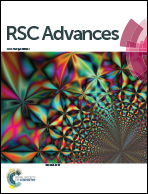Mn4+-activated oxyfluoride K3TaOF6 red phosphor with intense zero phonon line for warm white light-emitting diodes†
Abstract
The intense zero phonon line (ZPL) of the Mn4+:2E→4A2 transition can further promote the color rendering and luminous efficiency for high-quality white-emitting diodes (w-LEDs). In this article, a Mn4+-activated K3TaOF6 oxyfluoride red phosphor was synthesized via a facile two-step method. Its phase and morphology were characterized by X-ray diffraction, SEM and TEM. The as-prepared K3TaOF6:Mn4+ exhibits an intense absorption of blue light and a strong emission band peaking at 628 nm with a color purity as high as 96.4%. Attributed to the distorted octahedral coordination environment of Mn4+ ions, an intense ZPL emission was detected at 620 nm. By theoretical calculation, Mn4+ ions in the K3TaOF6 host experience a strong crystal field. In addition, the temperature-dependent PL and thermoluminescence (TL) spectra suggest that thermal ionization dominates the thermal quenching phenomenon in this phosphor.



 Please wait while we load your content...
Please wait while we load your content...